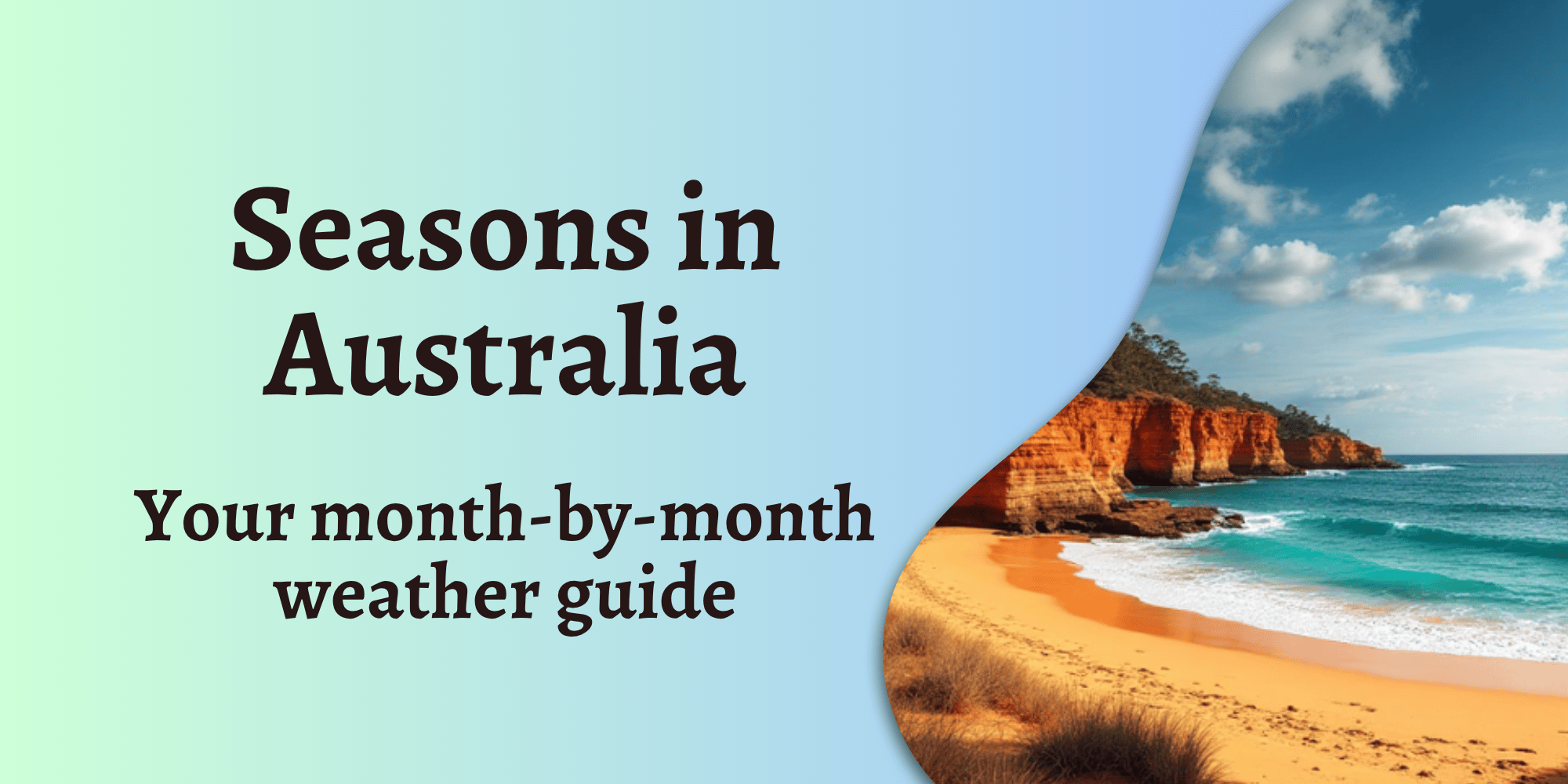Did you know that Australia’s seasons run completely opposite to those in the Northern Hemisphere? You might be enjoying a snowy December in Europe or North America while Australians head to the beach in their swimwear for summer fun.
The country experiences four distinct seasons throughout the year: summer (December to February), autumn (March to May), winter (June to August), and spring (September to November). The tropical north tells a different story with just two seasons – a wet season from November to April where temperatures can soar to 50 degrees Celsius, and a dry season from May to October with temperatures staying above 17 degrees Celsius. The weather patterns vary greatly between regions too. Southern cities have humid coastal weather, and inland areas face extreme heat and dry conditions.
Students preparing for study abroad or professionals moving for work should understand when winter begins and how seasons affect Australia’s different regions. This knowledge helps with packing the right clothes and planning activities. Let’s take a closer look at the weather patterns in a variety of regions across this vast continent.
Understanding the Australian Seasons
Australia’s location in the Southern Hemisphere creates a unique timing of seasons in Australia. This special position results in seasonal patterns that often puzzle visitors from northern countries.
Why Australia’s seasons are opposite to the Northern Hemisphere
Our Earth spins on a slightly angled axis relative to the sun. The planet’s yearly orbit around the sun causes each hemisphere to receive different amounts of sunlight. The Northern Hemisphere tilts away from the sun while the Southern Hemisphere tilts toward it. This basic astronomical pattern explains why Australians enjoy beach days during Christmas as Europeans build their snowmen.
The Earth’s axial tilt substantially affects daylight hours and temperatures. The sun appears directly above the Tropic of Capricorn during the southern summer solstice around December 22. This brings warmer temperatures and longer days to Australia.
Meteorological vs. astronomical seasons
The meteorological season system divides Australia’s year into four equal three-month periods based on the Gregorian calendar:
- Spring: September, October, November
- Summer: December, January, February
- Autumn: March, April, May
- Winter: June, July, August
The Bureau of Meteorology chose this system because it tracks temperature changes better and makes climate data compilation easier.
Astronomical seasons depend on Earth’s position relative to the sun, marked by solstices and equinoxes. The United States and most of Europe follow this system. Australia’s astronomical winter solstice happens around June 21, which marks the southern hemisphere’s shortest day.
What season is it in Australia right now?
Australia experiences winter now, based on today’s date (2025-06-03). Winter started officially on June 1st and will last until August 31st. Southern Australia sees cooler temperatures and shorter days during winter, though the experience varies across the continent.
The continent’s climate shows remarkable diversity. Northern tropical regions follow a simple two-season pattern: wet (November-April) and dry (May-October). This pattern reflects Australia’s varied climate zones.

Month-by-Month Weather Guide
Australia’s climate shows dramatic variations across its vast landscape. Each month brings its own unique weather patterns, from blazing summers to gentle winters.
January to March: Peak summer and early autumn
January stands as Australia’s hottest month. Desert temperatures soar above 30°C (86°F). Sydney and Brisbane see averages of 24-25°C (75-77°F), while Melbourne stays cooler at 20°C (68°F). The tropical north gets muggy and wet, and both Darwin and Cairns receive heavy rainfall.
Summer heat lingers through February until late month cooling signals autumn’s approach. Beach lovers should watch out for “Stinger Season” from November through May when jellyfish become active.
March welcomes autumn with cooler days and puts on a stunning show of fall colours. Victoria’s High Country, the Grampians, and Tasmania’s Cradle Mountain-Lake St Clair National Park burst into spectacular autumn displays.
April to June: Autumn transitions to winter
Sydney’s rainfall reaches 3.1 inches in April as temperatures start to fall. Brisbane’s coastal areas stay mild at 20°C (68°F) during the day.
Clear skies and crisp mornings define May across most regions. Sydney cools to 17°C (62°F), and Perth’s Mediterranean climate brings increased rainfall.
Winter arrives officially in June. The winter solstice falls between June 20-22, marking the year’s shortest day. Tasmania’s southeast experiences its coldest nights in late June.
July to September: Coldest months and early spring
July brings winter’s peak. Darwin stays warm at 25°C (77°F), while Melbourne dips to 10°C (50°F) and Hobart reaches just 8.5°C (47.5°F). Inland nights can drop below 0°C (32°F), and Canberra might even see snow.
Winter’s grip holds through August, bringing heavy rainfall to Perth. Ski enthusiasts head to the Australian Alps and Snowy Mountains during these winter months.
Spring arrives in September with warmer days and beautiful wildflower displays. Baby koalas and kangaroos make their first appearances, delighting wildlife watchers.
October to December: Spring blooms and summer begins
October warms up the entire country. Perth’s rainfall decreases while eastern coastal cities get wetter.
November heats up faster. Purple jacaranda blossoms create stunning photo opportunities nationwide.
Summer starts in December with hot Christmas celebrations that contrast sharply with the Northern Hemisphere’s winter festivities. Coastal regions stay pleasantly warm without the extreme heat found inland.
Regional Weather Differences Across Australia
Australia’s big landscape creates different climate zones across the continent. The country has everything from tropical rainforests to arid deserts. The seasons in Australia change by a lot based on where you are.
Tropical North: Wet and dry seasons explained
The tropical north has only two main seasons, unlike southern Australia’s four distinct ones. Darwin gets about 1,570mm of heavy rain each year during the wet season from November to April. The humidity climbs above 80% while temperatures stay between 25°C and 33°C.
The dry season runs from May to October with clear skies and pleasant temperatures between 21°C and 32°C. The humidity drops to 20-35%. This happens because high-pressure systems move north during Australia’s winter and bring cooler, drier air to the tropics.
Southern cities: Melbourne, Sydney, Adelaide
Melbourne, Sydney and Adelaide follow the four-season pattern with some key differences. Adelaide gets about 547mm of yearly rain, mostly in winter. Melbourne’s weather can be unpredictable. Winter temperatures range from 5-14°C while summer sees 13-26°C.
Sydney keeps a milder climate year-round. Winter temperatures rarely go below 8°C. Cool-season rainfall has dropped by around 9% over the last several years since 1994 across southern Australia.
Desert regions: Central Australia
Central Australia shows true desert conditions. Alice Springs gets just 291mm of rain yearly. Summer temperatures often climb above 35°C. The nights can get surprisingly cold in winter and sometimes drop below freezing.
Uluru’s rainfall patterns are unpredictable. The lowest yearly rainfall was only 82mm in 1965, while the highest reached 935mm in 1974.
Coastal zones and island climates
Australia’s long coastline creates many unique microclimates. The southwestern coast has a Mediterranean weather pattern. Perth gets 80% of its yearly rain between May and September.
Northern Queensland’s coastal areas follow the tropical pattern with their own twist. Cairns gets almost 2,000mm of rain each year, mostly during wet season. Hobart in Tasmania enjoys mild weather year-round with steady rainfall across all seasons.
What to Expect Each Season
Australia’s seasons each bring their own unique character and create amazing opportunities for everyone. The country transforms from colourful blooms to snow-covered mountains throughout the year.
Spring: Flowers, festivals, and mild weather
Australia wakes up in spring with impressive floral displays and pleasant temperatures between 10°C to 20°C. Jacaranda trees create a purple canopy over towns, especially in October. The season bursts with celebrations like Canberra’s Floriade from September to October, where millions of flowers create beautiful displays. Nature photographers love this time because baby koalas and kangaroos make their first appearances. The cities buzz with events such as the Brisbane Festival in September that features world-class performances and spectacular fireworks.
Summer: Heatwaves, beach days, and bushfires
Summer temperatures typically range from 20°C to 37°C. The coastal cities stay warm but pleasant, while the northern regions heat up with humid days that often reach above 35°C. Beach life is at its peak during these months. Swimmers should remember that “Stinger Season” runs from November through May in northern waters. The risk of bushfires peaks in summer, especially in southern regions with hot and dry weather. Australians celebrate Christmas in warm weather—quite different from Northern Hemisphere traditions.
Autumn: Crisp air, changing leaves, and harvests
Autumn paints Australia with cooler temperatures and beautiful foliage. The countryside comes alive with reds, oranges, and golds that photographers love to capture. Tasmania offers a unique sight called the “turning of the Fagus” as the Tasmanian Deciduous Beech turns from green to gold. Farmers harvest their crops nationwide, from grains to apples and oranges. Food lovers can enjoy events like Tasting Australia and Clare Valley Gourmet Weekend.
Winter: Snow in the Alps, dry warmth in the north
Winter creates Australia’s most striking regional differences. The Australian Alps get heavy snowfall—more than the Swiss Alps during winter! Ski enthusiasts flock to the Snowy Mountains, where areas above 1,400 metres stay snow-covered consistently. The northern parts of Australia enjoy a dry season with warm days and cool nights. This weather makes it perfect to explore Darwin, the Top End, and the Kimberley. Whale watching becomes popular along the coast, and truffle hunting draws crowds to Canberra’s annual Truffle Festival.
Conclusion
You need to understand seasons in Australia if you’re planning a holiday, relocating for work, or just curious about this diverse continent. Australia doesn’t fit into a simple category. Cities in the south like Melbourne, Sydney, and Adelaide follow the traditional four-season pattern with winters milder than most Northern Hemisphere locations. The tropical north runs on its own calendar where wet and dry seasons shape the weather patterns year-round.
Such diversity lets you ski the snowy slopes of the Australian Alps while others swim at tropical beaches in Queensland in the same month. Australian winter (June-August) shows amazing regional differences – from crisp, sometimes snowy conditions in Tasmania to perfect dry season weather in the northern territories.
Smart preparation makes all the difference when visiting Australia. Pack based on your specific destination instead of expecting the same weather everywhere. You’ll need different clothes for Northern Queensland than you would for Melbourne or Perth any given month.
Each Australian season gives you unique experiences to explore. Spectacular wildflower displays and wildlife viewing come with spring. Summer brings perfect beach weather to coastal regions. Autumn paints landscapes with vibrant foliage. Winter offers both alpine adventures and tropical getaways.
Australia’s climate diversity ranks among its biggest draws. Snow-capped mountains, sun-drenched beaches, or outback adventures – Australia’s seasonal calendar gives you options all year. Pick your activities and destinations wisely and you’ll see firsthand why this continent fascinates visitors whatever time they arrive.

